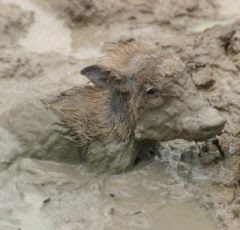Winter fog above the Columbia River that contributes to the danger of Deadman Pass
Geology plays a part in the unique conditions there, so to does the area's weather and climate. The eastern side of Deadman Pass is high rolling alpine country akin to so much of the west's terrain. It's cold/dry climate makes for powdery snow that may blow around a bit but seldom goes through the freezing/thawing cycles so evident on the western side of the pass heading down toward Pendelton, Oregon. The I-84 highway's western side is very steep and drops down into a totally different geology and climate who's weather is dominated by the Columbia River some miles further west.
Fog created by the river's relatively warmer water often covers all the bench lands adjacent to the Colombia for miles in every direction, all the way to the Blue Mountains which Deadman Pass traverses. In late winter/early spring its easy to see the climatic difference because the eastern side is still cold and snow covered while at the same time the western side's bench lands are already green. Where that warmer, wetter rising air mass meets the colder, dryer descending high country air.the roads become treacherous.
Heading east from Pendelton a person is climbing a steep switch backed grade up to the pass so it's far easier, no matter what time of day it is, to control and slow a vehicle even when the road surface is ice covered. Heading west, downhill, is a different story. The big rigs all stop before the drop off and shift down into a low gear then let the engine's compression control its speed both because overheated brakes are useless and applying them on ice is too. Car drivers though usually don't stop and put their automatic tranny down into low gear and consequently end up having to slow down quickly behind a big truck and often end up in trouble.Added to that is the fact that on most days there is really only one lane in each direction that is at all clear of ice and snow and that lane is full of big rigs slowly ascending or descending. So trying to pass the slow moving rigs in either direction means pulling out onto an even more dangerous surface.
Imagine yourself breezing over Deadman Pass heading west, dry road and sunny skies in your rearview mirror, icy roads and fog in front of you. Within seconds you're gaining way to fast on rear end of a rig. What to do? You're already going to fast for the grade, another car behind you is heading out into the left [passing] lane and you know even touching your brakes could be the last move you make...yikes!
So, the best advice for my fellow snowbirds and road warriors is to use I-84 when you're going east in the winter months. But during the winter either avoid driving west over Deadman altogether or, if unavoidable, wait until the warmest part of the day, mid-afternoon, when its most likely that the ice caused by the interaction of the Columbia's foggy presence and the high country cold air has melted on the road's surfaces.
For sure Deadman is on the easiest, quickest, and shortest route between the Pacific Northwest's dark grey winters and the bright skies of the sagebrush nation which lead to points south. My advice is to use I-84 over Deadman to, like The Beach Boys said, "get there fast, then take it slow". There's lottsa beautiful routes to take north when ya gotta turn back that don't include heading west over the top of Deadman Pass in the winter, eh.



